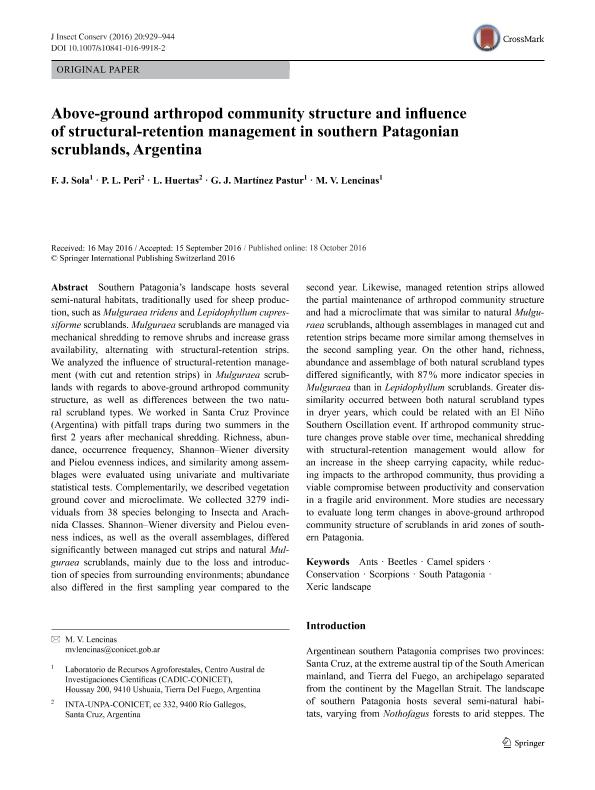Artículo
Above-ground arthropod community structure and influence of structural-retention management in southern Patagonian scrublands, Argentina
Sola, Francisco Javier ; Peri, Pablo Luis
; Peri, Pablo Luis ; Huertas, Laura Eugenia; Martínez Pastur, Guillermo José
; Huertas, Laura Eugenia; Martínez Pastur, Guillermo José ; Lencinas, María Vanessa
; Lencinas, María Vanessa
 ; Peri, Pablo Luis
; Peri, Pablo Luis ; Huertas, Laura Eugenia; Martínez Pastur, Guillermo José
; Huertas, Laura Eugenia; Martínez Pastur, Guillermo José ; Lencinas, María Vanessa
; Lencinas, María Vanessa
Fecha de publicación:
12/2016
Editorial:
Springer
Revista:
Journal of Insect Conservation
ISSN:
1366-638X
Idioma:
Inglés
Tipo de recurso:
Artículo publicado
Clasificación temática:
Resumen
The landscape of South Patagonia hosts several semi-natural environments traditionally used for sheep production, such as Mulguraea tridens and Lepidophyllum cupressiforme scrublands, which are managed by removal to increase grass availability, alternating with structural-retention strips. We analyzed the influence of structural-retention management (with cut areas and retention strips) in Mulguraea scrublands on above-ground arthropod assemblages, as well as differences between the two scrubland types in natural conditions and the effect of climatic variations caused by El Niño Southern Oscillation (ENSO) event. We worked in Santa Cruz province (Argentina) with pitfall traps during two summers, and evaluated richness, abundance, occurrence frequency, Shannon-Wiener diversity and Pielou evenness indices, and assemblage using univariate and multivariate tests. Complementarily, we described vegetation, floor cover and microclimate. We collected 3279 individuals of 38 species belonging to Classes Insecta and Arachnida. Diversity in Mulguraea cut areas statistically differed from those at natural conditions, mainly by loss and introduction of species from surrounding environments. While retention strips allows partially maintaining microclimate and legacies of the natural scrubland. On the other hand, assemblages of both natural scrubland types differed in richness and composition, with 87% more indicator species in Mulguraea than in Lepidophyllum scrubland. Greater dissimilarity occurred between both scrubland types in dryer years (with positive Multivariate ENSO Index). If arthropod diversity changes prove stable over time, this technique would allow for an increase in loading capacity for sheep production while reducing impacts on the arthropod community, thus providing a viable compromise between productivity and conservation in a fragile arid environment. Undoubtedly, some completely uncut areas would need to be maintained in proximity to provide reservoirs of scrubland specific species (Mazía et al., 2006). Further follow-up sampling will be required to determine the outcome of this experimental manipulation. More studies are necessary to evaluate long term changes in above-ground arthropod diversity of scrublands in arid zones of South Patagonia.
Palabras clave:
Beetles
,
Ants
,
Camel Spiders
,
Scorpions
,
Conservation
,
Xeric Landscape
,
South Patagonia
Archivos asociados
Licencia
Identificadores
Colecciones
Articulos(CADIC)
Articulos de CENTRO AUSTRAL DE INVESTIGACIONES CIENTIFICAS
Articulos de CENTRO AUSTRAL DE INVESTIGACIONES CIENTIFICAS
Articulos(SEDE CENTRAL)
Articulos de SEDE CENTRAL
Articulos de SEDE CENTRAL
Citación
Sola, Francisco Javier; Peri, Pablo Luis; Huertas, Laura Eugenia; Martínez Pastur, Guillermo José; Lencinas, María Vanessa; Above-ground arthropod community structure and influence of structural-retention management in southern Patagonian scrublands, Argentina; Springer; Journal of Insect Conservation; 20; 6; 12-2016; 929-944
Compartir
Altmétricas



